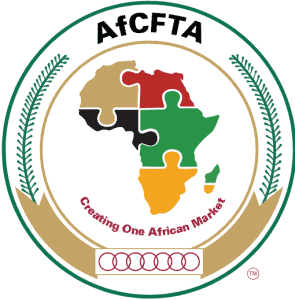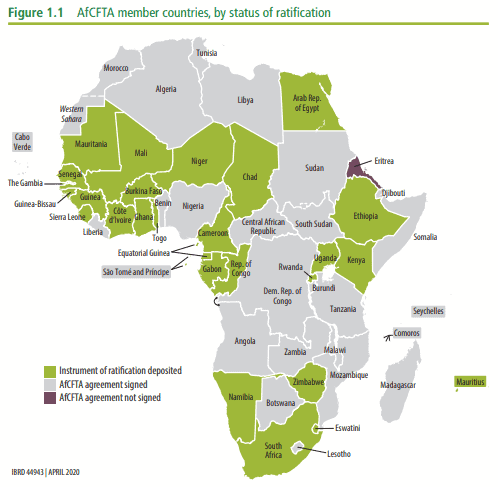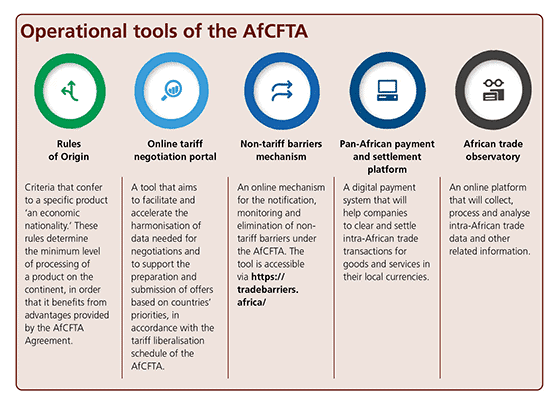As part of our ongoing series on important trade agreements, this week we will be analyzing the African Continental Free Trade Area (AfCFTA). A new trade agreement that has already proven to be a game-changer for global trade. In this article, we will delve into what the AfCFTA is, its significance, and how it is changing the trade landscape in Africa.
What is the AfCFTA? The New Trade Deal that is Changing Global Trade
The AfCFTA is a free trade area that covers almost the entirety of the African continent. It was brokered by the African Union (AU) and signed on March 21, 2018, in Kigali, Rwanda. The agreement aims to create a single market for goods and services in Africa, facilitate the free movement of people, and spur economic growth and development across the continent.
The AfCFTA has 54 signatories, making it the largest free trade area in terms of the number of member states, second only to the World Trade Organization. It is also the largest in terms of both population and geographic size, encompassing over 1.3 billion people across the African continent.
This ambitious trade pact creates a single market for goods and services across member states and deepens the economic integration of Africa. It is expected that the trade area created by this agreement could have a combined gross domestic product of approximately $3.4 trillion USD.
Timeline & Events that Shaped the AfCFTA

Although trade under the African Continental Free Trade Area (AfCFTA) commenced on January 1, 2021, it is important to note that the process leading up to this point was a lengthy one, spanning several years. The agreement itself was signed in 2018, but it took many years of negotiations, consultations, and deliberations to reach that point. Roots of the AfCFTA date back to the 19th Session of the African Union (AU) in 2012, where African Heads of State and Government came to the decision to establish a free trade area across the continent by 2017.
The official negotiations for the African Continental Free Trade Area (AfCFTA) launched in 2015 by African Heads of State and Government at the 25th Ordinary Session of the AU. These negotiations continued until March 2018, where the agreement was signed at the 10th Extraordinary Session of the AU Assembly of Heads of States and Government, where 44 of the 55 African Union Member States signed the Agreement establishing the African Continental Free Trade Area (AfCFTA).
Almost exactly a year following the signing of the agreement, the AfCFTA entered into force on May 30, 2019. The operational phase of the African Continental Free Trade Area (AfCFTA) was launched during the 12th African Union (AU) Assembly in July 2019. At the time, 27 countries had ratified the AfCFTA, while 28 others had signed but not yet ratified
As of February 2023, 46 of the 54 signatories have deposited their instruments of ratification for the agreement, making them state parties to the agreement.
While trading under the agreement commenced on January 1, 2021, there are still negotiations taking place to finalize all aspects of the agreement. These negotiations have been divided into three phases;
Phase I: Trade in goods and services and dispute settlement
- Despite trading under the agreement being permitted, negotiations continue for various details such as tariff schedules, rules of origin, the Trade Remedy Guidelines, and services commitments for the five priority sectors for liberalization (Transport, communication, financial, tourism and business services).
Phase II: Intellectual property rights, investment, and competition policy
- Negotiations for Phase II have commenced, and were disrupted by the COVID-19 Pandemic, resulting in delays. However, the negotiations to conclude the outstanding Protocols of Phase II are well advanced and should be completed soon.
Phase III: Digital trade and women and youth in trade
- Negotiations for Phase III will commence upon the completion of Phase II.
The AfCFTA’s Key Objectives, Expectations & Operational Tools
According to the World Bank, The AfCFTA agreement aims to provide broader and deeper economic integration across the continent as well as attract investment, boost trade, provide better jobs, reduce poverty and increase shared prosperity in Africa.
The AfCFTA aims to achieve the following general objectives:
- Lay the foundation for the establishment of a Continental Customs Union;
- Liberalizing intra-African trade;
- Resolve the challenges of overlapping memberships in regional economic communities and expedite the regional and continental integration processes;
- Enhance competitiveness of the economies of state parties within the continent and global market;
- Contribute to the movement of capital and natural persons and facilitate investment;
- Promote and attain sustainable and inclusive socio-economic development, gender equality and structural transformation of the State Parties;
- Promote industrial development through diversification and regional value chain development, agricultural development
To actualize these general objectives, the AfCFTA lays out seven framework protocols for all State Parties to adhere to;
- Eliminate tariffs and non-tariff barriers to trade in goods progressively;
- Liberalize trade in services progressively;
- Cooperate on investment, intellectual property rights and competition policy;
- Cooperate on all trade-related issues;
- Cooperate on customs matters and the implementation of trade facilitation measures;
- Establish a mechanism for the settlement of disputes concerning their rights and obligations;
- Establish and maintain an institutional framework for the implementation and administration of the AfCFTA
Each protocol sets out a specific agenda, describing what exactly is intended, the timeline for achieving it and benchmarks for assessing the results.
Furthermore, to operationalize the agreement, the following five operational tools have been adopted;
- Rules of Origin;
- Online Tariff Negotiation Portal;
- Non-Tariff Barriers Mechanism;
- Pan-African Payment and Settlement Platform;
- African Trade Observatory
The Continental and Global Impact of the AfCFTA
The significance of the AfCFTA cannot be overstated. The agreement’s scope is quite large and has ambitious aims for the continent. The African Continental Free Trade Area (AfCFTA) presents a significant prospect for countries in Africa, as it has the potential to transform markets and economies throughout the region. It is projected to have a positive impact on the output of various sectors such as services, manufacturing, and natural resources, which would translate to increased economic growth and development. It is estimated that the AfCFTA has the potential both to boost intra-Africa trade by 52.3% by eliminating import duties and to double this trade if non-tariff barriers are also reduced. Furthermore, the AfCFTA is expected to expand the size of Africa’s economy to US$29 trillion by 2050.
The full implementation of the AfCFTA also has the ability to significantly improve the lives of people across the African Continent. The World Bank estimates that the AfCFTA could lift 30 million Africans out of extreme poverty and boost the incomes of nearly 68 million others who live on less than $5.50 a day, boost wages for skilled workers by 9.8% and the wages for unskilled workers by 10.3%, and spur larger wage gains for women, estimating a 10.5% wage spur for women compared to a 9.9% wage spur for men.
The agreement will not only have enormous continental impacts, but it will also have significant global impacts. As it is now the largest free trade area in the world in terms of membership, population and geographic size, this agreement is a game changer for global trade. The world bank has also estimated that the agreement could also boost Africa’s income by $450 billion by 2035 (a gain of 7 percent) while adding $76 billion to the income of the rest of the world
Furthermore, the agreement could boost Africa’s income by $450 billion by 2035 (a gain of 7 percent) while adding $76 billion to the income of the rest of the world and increase Africa’s exports by $560 billion, estimated to mostly be in manufacturing.
In conclusion, the AfCFTA is a game changer for global trade agreements. The agreement has the potential to significantly boost economies, reduce poverty, promote gender equality, and improve governance. With the potential to expand Africa’s economy to US$29 trillion by 2050, the AfCFTA is transforming the African economy and becoming a model for cross-border cooperation worldwide.









